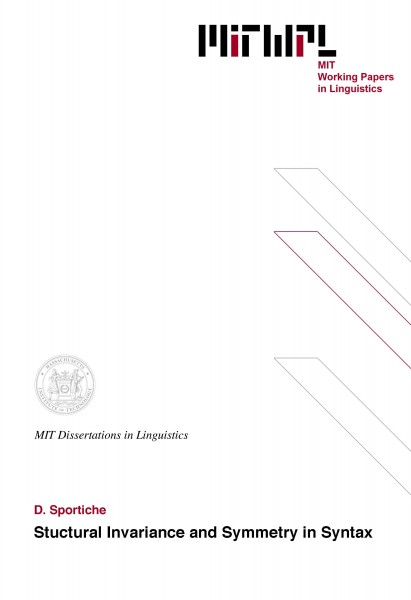Stuctural Invariance and Symmetry in Syntax
D. Sportiche, 1983
This essay investigates the incidence of the Isomorphy Principle, a principle of thematic invariance across levels of syntactic representations, on the nature of the relations between these levels, within the model of Universal Grammar proposed by the Transformational Generative Theory (the Government and Binding framework). This leads us to undertake a reanalysis of various syntactic dependencies "move NP, move-wh"- and to develop a theory of f-categories and correlatively a theory of Binding relations.
Move NP is exclusively studied from the point of view of syntactic chains, from which its properties will be shown to be entirely derivative: this result entails primarily that D-structure is not an independent level of representation.
Move-wh and more generally the theory of the set of A"/A relations is investigated. We show that this set is symmetric with respect to the value of any binary classificatory features used. In particular, we conclude that invariance across levels is one such feature so that A"/A relation types partition equally depending on whether they remain invariant across levels or not: we also deduce that clitic constructions do not involve an A"/A relation.
The set of f-categories is also shown to be closed under symmetry. From this, we conclude that there is no type distinction between expletive PRO and NP-trace, and between pronouns, resumptive pronouns, wh-traces and pro. This last result is the conceptual cornerstone of our treatment of Weak Crossover, Strong Crossover and Parasitic Gap structures. We conclude as well that PRO is a "pure" anaphor and that the theory of its referential properties " Control Theory " partly reduces to Binding Theory, partly to the theory of the range of non-overt operators.
Thesis supervisor: Noam Chomsky
Title: Institute Professor
Table of Contents
Introduction 7
1 Setting 7
2 Assumptions 8
2.1 The base 10
2.2 Government theory 11
2.3 q-theory 12
2.4 Case theory 14
2.5 Binding theory 15
2.6 The Empty Category Principle (ECP) 16
2.7 Bounding theory 17
3 Summary of contents 17
Chapter I Invariance of thematic structure: the isomorphy principle 21
1 Congruence between levels of representations 21
2 Non-isomorphic cases of movement 25
3 Extended non-isomorphic derivations 34
4 Why are there non-isomorphic derivations 35
Footnotes to Chapter I 39
Chapter II Chain Theory 40
0 S-structure as the basic level of representation 40
1 On the theory of chains 42
1.1 Introduction 42
1.2 Some remarks on Chomsky"s theory of chains 43
2 Formal properties of chains 46
2.1 Chains and NP-types 46
2.2 The positions of GF-q in a chain 48
2.3 The Case position in a chain 54
2.4 Position of the argument in a chain 61
2.5 Maximality and uniqueness of chains 63
2.6 Empty Categories and cateogry classification 68
2.6.1 Heads of chains, case filter and visibility 69
2.6.2 Non-heads of chains 82
Footnotes to Chapter II
Chapter III A"/A relations 91
1 The Map Principle 91
2 Variables and the level of application of The Map Principle 94
3 Properties and parameters of A"/A relations 97
4 Level of relevance of A"/A relations properties 99
4.1 The subjacency condition 99
4.2 Parasitic gaps 106
4.3 Weak crossover 109
5 A classification of A"/A relations 113
6 Clitic constructions 133
6.1 Chomsky"s analysis 133
6.2 Clitic constructions as LF A"-binding 137
6.3 Problems with clitics as LF A"-binders 140
7 Strong crossover 146
8 Parasitic gaps and WCO 157
8.1 The basic parallelism of PG and WCO structures 157
8.2 Breach of parallelism 163
8.2.1 Heavy NP-shift 164
8.2.2 Relative clauses 165
8.2.3 PG and subjacency 171
8.2.4 Caseless PG 174
8.3 Further remarks on WCO 177
8.4 On the definition of variables 179
9 Improper movement and successive cyclicity 180
9.1 Improper movement 181
9.2 Successive cyclicity and related matters 183
Footnotes to Chapter III 187
Appendix The structure of clitic constructions 196
0 Introduction 196
1 Pronominal and reflexive/reciprocal clitics 198
1.1 Clitic constructions and A-binding 199
1.2 Clitics and chains 202
1.3 Clitics as agreement marker 207
1.4 Summary 210
2 Subject clitics 212
2.1 Analysis of SCL constructions 213
2.2 Complex inversion 216
2.3 Clitic doubling 218
Footnotes Appendix 221
Chapter IV f-categories and binding theory 225
1 The nature of the problem 225
1.1 Introduction 225
1.2 Questions on the Binding Theory 226
1.3 Are lexical anaphors f-categories 227
1.4 The problem of f-categories classification 230
2 The classification of f-categories 231
2.1 Classificatory dimensions 231
2.2 The semantically based inventory 234
2.2.1 Arguments 234
2.2.2 Non-arguments 244
2.2.3 Consequences and problems 249
2.3 The formally based inventory 256
2.4 Summary 262
3 Binding principles and the distribution of PRO 264
3.1 Government, case-marking, and PRO 265
3.1.1 Case-marked ungoverned positions 266
3.1.2 Governed caseless positions 270
3.2 Formulation of the binding principles 279
3.2.1 On SUBJECTS and binding domains 280
3.2.2 Binding domains 283
3.2.3 Some further remarks and outstanding problems 287
4 ECP and expletive PRO 288
4.1 Where does the binding theory apply? 288
4.2 What does the ECP apply to? 289
4.2.1 ECP for pro=ECP for NP-traces 290
4.2.2 The distribution of expletive PRO 290
5 Remarks on Control Theory 293
5.1 The obligatory/non-obligatory control distinction 293
5.2 Obligatory control 295
5.3 Non-obligatory control 299
6 Caseless variables 304
6.1 Must variables have Case 305
6.2 Some consequences 307
6.2.1 Symmetry of f-categories classification 307
6.2.2 On deriving the CEP 307
6.2.3 Obligatory control 308
6.2.4 Non-obligatory control 309
6.2.5 PG/WCO and PRO 311
6.2.6 Summary 312
Footnotes to Chapter IV 313

